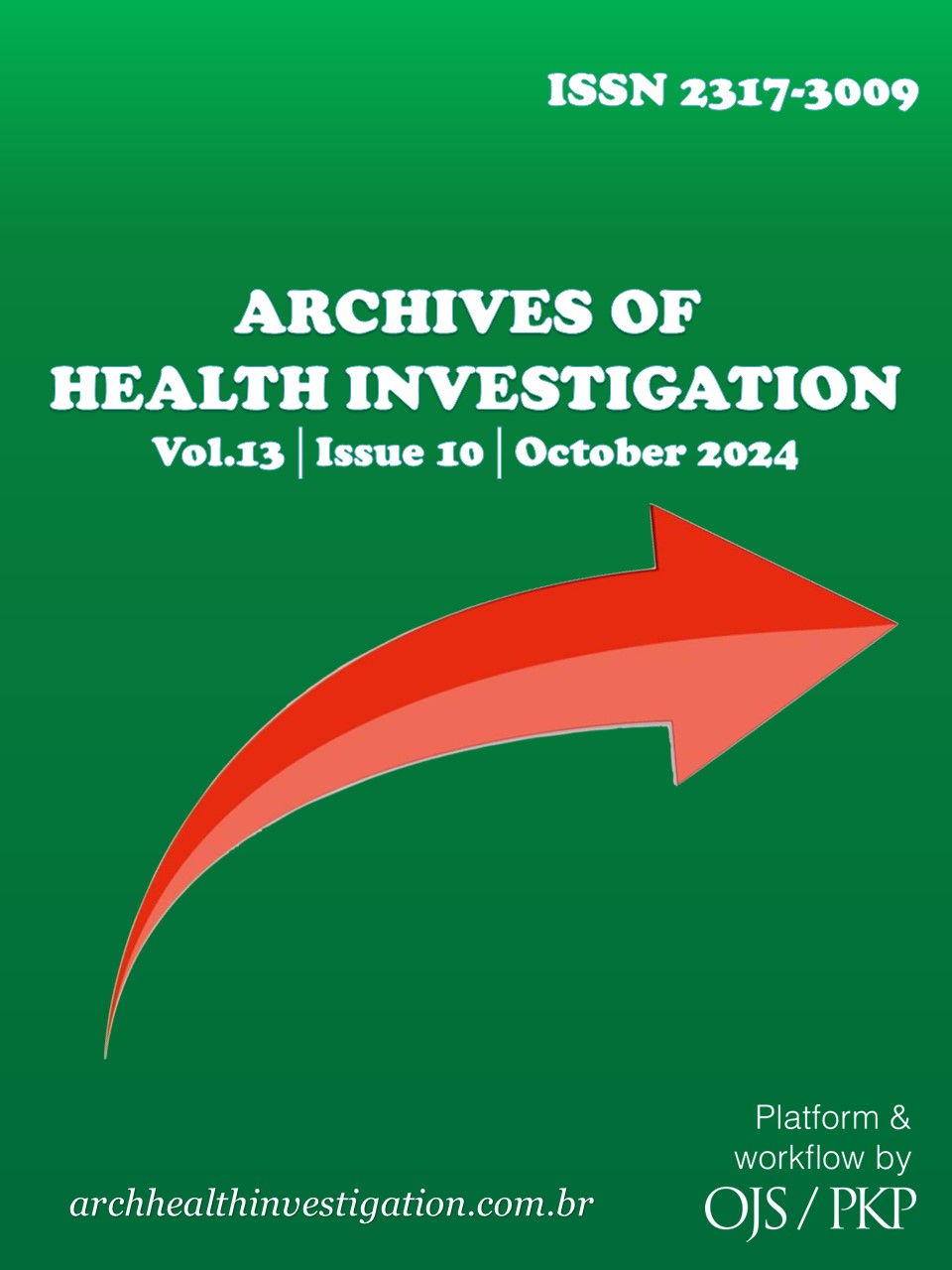Síndrome Del Diente Trincado: Evaluación de la Prevalencia a Partir del Análisis de Prontuarios
DOI:
https://doi.org/10.21270/archi.v13i10.6452Palavras-chave:
Diagnóstico, Prevalencia, Síndrome de Diente FisuradoResumo
El síndrome de dientes agrietados tiene una alta prevalencia en la sociedad, sin embargo, es poco notada y registrada. Su tratamiento se ha vuelto cada vez más desafiante, pues se trata de una situación clínica de difícil diagnóstico. El objetivo del presente estudio fue identificar, a través del análisis de prontuarios, la prevalencia de este síndrome en pacientes atendidos en el Centro Universitário Doutor Leão Sampaio - UNILEÃO. Se realizó un estudio transversal por medio del levantamiento de 155 prontuarios de los últimos cinco años, siendo analizados la denuncia principal, el análisis de la odontograma y el plan de tratamiento realizado. La prevalencia de grietas en las estructuras dentales en el período descrito fue de 10,3%. Tras ser identificadas, se notó que el 75% de estos pacientes presentaron considerables pérdidas dentales y que el 37,5% presentaron algún tipo de sensibilidad dolorosa. Se observó que en 117 (75,5%) de los historiales analizados había registros de carillas de desgaste, 118 (76,1%) presentaron múltiples pérdidas dentales y 79 (51,0%) presentaron restauraciones extensas. No hubo necesidad de tratamiento invasivo para las grietas investigadas. De acuerdo con los resultados, supone que la baja prevalencia del síndrome del diente agrietado puede explicarse por la falta de una estenografía específica para grietas dentales, por fallas durante la realización de la odontograma y por la dificultad en el diagnóstico. De esta forma, se cree que hubo una posible subnotificación de las grietas dentales, que es una condición esencial en la planificación y éxito del tratamiento.
Downloads
Referências
Bailey O, Whitworth J. Cracked tooth syndrome diagnosis part 1: integrating the old with the new. Dental Update. 2020;47(6):494-99.
Avelar WV, Medeiros AF, Ramos TO, Vasconecelos MG, Vasconcelos RG. Síndrome do Dente Rachado: Etiologia, Diagnóstico, Tratamento e Considerações Clínicas. Odontol Clín-Cient. 2017;16(1):7-13.
Lee SH, Lee JJ, Chung HJ, Park JT, Kim HJ. Dental optical coherence tomography: new potential diagnostic system for cracked-tooth syndrome. Surg Radiol Anat. 2016;38(1):49-54.
Hasan S, Singh K, Salati N. Cracked tooth syndrome: Overview of literature. Int J Appl Basic Med Res. 2015;5(3):164-68.
Xie N, Wang P, Wu C, Song W, Wang W, Liu Z. Impact of cusp inclinations on dental fractures in cracked tooth syndrome model and relevant risk evaluation. Exp Ther Med. 2017;14(6):6027-33.
Charlas, R.; Hänni, S. Cracked Tooth Syndrome. In: Neuhaus, K.; Lussi, A. Management of Dental Emergencies in Children and Adolescents, Hoboken, NJ: Wiley Blackwell, cap. 7, p. 275-81, 2019.
Leite, M.M.; Rodrigues, P.C.F.; Souza, J.B.; Barata, T.J.E.; Lopes, L.G. Diagnóstico, plano de tratamiento y restauración de un diente con el síndrome del diente fisurado: reporte de caso y seguimiento de siete años. Rev Estomatol Herediana. 2019;29(2);152-57.
Zuckerman GR. The cracked tooth. N Y State Dent J. 1998;64(6):30-5
Pereira ECPLC, Silva HMC, Vasconcelos RA, Cabral LL. Análise da prevalência da síndrome do dente rachado: revisão integrativa da literatura. Semana de Pesquisa do Centro Universitário Tiradentes-SEMPESq-Alagoas, n. 8, 2020.
Mamoun JS, Napoletano D. Cracked tooth diagnosis and treatment: An alternative paradigm. Eur J Dent. 2015;9(2):293-303.
Yu M, Li J, Liu S, Xie Z, Liu J, Liu Y. Diagnosis of cracked tooth: Clinical status and research progress. Jpn Dent Sci Rev. 2022;58:357-64.
Hiatt WH. Incomplete crown-root fracture in pulpal-periodontal disease. J Periodontol. 1973;44(6):369-79.
Hilton TJ, Funkhouser E, Ferracane JL, Gilbert GH, Gordan VV, Bennett S, et al. Symptom changes and crack progression in untreated cracked teeth: One-year findings from the National Dental Practice-Based Research Network. J Dent. 2020;93:103269.
Geurtsen W, Schwarze T, Gunay H. Diagnosis, therapy, and prevention of the cracked tooth syndrome. Quintessence Int. 2003;34(6):409-17.
Kanamaru J, Tsujimoto M, Yamada S, Hayashi Y. The clinical findings and managements in 44 cases of cracked vital molars. J Dent Sci. 2017;12(3):291-95.
Hilton TJ, Funkhouser E, Ferracane JL, Gilbert GH, Baltuck C, Benjamin P,et al. Correlation between symptoms and external characteristics of cracked teeth: Findings from The National Dental Practice-Based Research Network. J Am Dent Assoc. 2017;148(4):246-56.e1.
Banerji S, Mehta SB, Millar BJ. The management of cracked tooth syndrome in dental practice. Br Dent J. 2017;222(9):659-66.
Seo DG, Yi YA, Shin SJ, Park JW. Analysis of factors associated with cracked teeth. J Endod. 2012;38(3):288-92.
Lynch CD, McConnell RJ. The cracked tooth syndrome. J Can Dent Assoc. 2002;68(8):470-75.
Roh BD, Lee YE. Analysis of 154 cases of teeth with cracks. Dent Traumatol. 2006;22(3):118-23.
Consolaro A. Diagnosis of occlusal trauma: Extrapolations for peri-implant bone region can be done. Dental Press Implantol. 2012;6(4):22-37.
Monteiro Junior S, Andrada MACA, Schrickte N, Arcari GM. Síndrome do dente rachado. JBD. 2002; 1(3):185-92.
Ingervall B. Tooth contacts on the functional and nonfunctional side in children and young adults. Arch Oral Biol. 1972;17(1):191-200.
Hilton TJ, Funkhouser E, Ferracane JL, Schultz-Robins M, Gordan VV, Bramblett BJ, et al. Recommended treatment of cracked teeth: Results from the National Dental Practice-Based Research Network. J Prosthet Dent. 2020;123(1):71-8.
Prasad DK, Shetty NS, Solomon EGR. The influence of occlusal trauma on gingival recession and gingival clefts. J Indian Prosthodont Soc. 2013;13(1):7-12.
Jepsen S, Caton JG, Albandar JM, Bissada NF, Bouchard P, Cortellini P, et al. Periodontal manifestations of systemic diseases and developmental and acquired conditions: Consensus report of workgroup 3 of the 2017 World Workshop on the Classification of Periodontal and Peri-Implant Diseases and Conditions. J Periodontol. 2018;89 Suppl 1:S237-S248.


